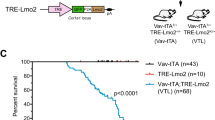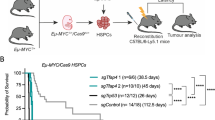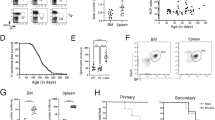Abstract
Chromosomal translocations involving immunoglobulin heavy chain (Igh) switch regions and an oncogene such as Myc represent initiating events in the development of many B cell malignancies. These translocations are widely thought to result from aberrant class-switch recombination. To test this model, we measured translocations in mice deficient in activation-induced cytidine deaminase (AID) that lack class-switch recombination. We found that AID made no measurable contribution to the generation of initial translocations, indicating that the intrinsic fragility of the switch regions or a pathway unrelated to AID is responsible for these translocations. In contrast, the outgrowth of translocation-positive cells was dependent on AID, raising the possibility that AID is important in tumor progression, perhaps by virtue of its mutagenic properties.
This is a preview of subscription content, access via your institution
Access options
Subscribe to this journal
Receive 12 print issues and online access
$209.00 per year
only $17.42 per issue
Buy this article
- Purchase on Springer Link
- Instant access to full article PDF
Prices may be subject to local taxes which are calculated during checkout




Similar content being viewed by others
References
Mitelman, F. Recurrent chromosome aberrations in cancer. Mutat. Res. 462, 247–253 (2000).
Willis, T.G. & Dyer, M.J. The role of immunoglobulin translocations in the pathogenesis of B-cell malignancies. Blood 96, 808–822 (2000).
Kuppers, R. & Dalla-Favera, R. Mechanisms of chromosomal translocations in B cell lymphomas. Oncogene 20, 5580–5594 (2001).
Lieber, M.R. Warner-Lambert/Parke-Davis Award Lecture. Pathological and physiological double-strand breaks: roles in cancer, aging, and the immune system. Am. J. Pathol. 153, 1323–1332 (1998).
Bergsagel, P.L. & Kuehl, W.M. Chromosome translocations in multiple myeloma. Oncogene 20, 5611–5622 (2001).
Mills, K.D., Ferguson, D.O. & Alt, F.W. The role of DNA breaks in genomic instability and tumorigenesis. Immunol. Rev. 194, 77–95 (2003).
Vanasse, G.J. et al. Genetic pathway to recurrent chromosome translocations in murine lymphoma involves V(D)J recombinase. J. Clin. Invest. 103, 1669–1675 (1999).
Petiniot, L.K. et al. Recombinase-activating gene (RAG) 2-mediated V(D)J recombination is not essential for tumorigenesis in Atm-deficient mice. Proc. Natl. Acad. Sci. USA 97, 6664–6669 (2000).
Difilippantonio, M.J. et al. Evidence for replicative repair of DNA double-strand breaks leading to oncogenic translocation and gene amplification. J. Exp. Med. 196, 469–480 (2002).
Zhu, C. et al. Unrepaired DNA breaks in p53-deficient cells lead to oncogenic gene amplification subsequent to translocations. Cell 109, 811–821 (2002).
Gladdy, R.A. et al. The RAG-1/2 endonuclease causes genomic instability and controls CNS complications of lymphoblastic leukemia in p53/Prkdc-deficient mice. Cancer Cell 3, 37–50 (2003).
Muramatsu, M. et al. Specific expression of activation-induced cytidine deaminase (AID), a novel member of the RNA-editing deaminase family in germinal center B cells. J. Biol. Chem. 274, 18470–18476 (1999).
Muramatsu, M. et al. Class switch recombination and hypermutation require activation-induced cytidine deaminase (AID), a potential RNA editing enzyme. Cell 102, 553–563 (2000).
Wuerffel, R.A., Du, J., Thompson, R.J. & Kenter, A.L. immunoglobulin Sg3 DNA-specific double strand breaks are induced in mitogen-activated B cells and are implicated in switch recombination. J. Immunol. 159, 4139–4144 (1997).
Kenter, A. & Wuerffel, R. Immunoglobulin switch recombination may occur by a DNA end-joining mechanism. Ann. NY Acad. Sci. 870, 206–217 (1999).
Petersen, S. et al. AID is required to initiate Nbs1/g-H2AX focus formation and mutations at sites of class switching. Nature 414, 660–665 (2001).
Catalan, N. et al. The block in immunoglobulin class switch recombination caused by activation-induced cytidine deaminase deficiency occurs prior to the generation of DNA double strand breaks in switch m region. J. Immunol. 171, 2504–2509 (2003).
Rush, J.S., Fugmann, S.D. & Schatz, D.G. Staggered AID-dependent DNA double strand breaks are the predominant DNA lesions targeted to Sm in immunoglobulin class switch recombination. Int. Immunol. 16, 549–557 (2004).
Chaudhuri, J. & Alt, F.W. Class-switch recombination: interplay of transcription, DNA deamination and DNA repair. Nat. Rev. Immunol. 4, 541–552 (2004).
Revy, P. et al. Activation-induced cytidine deaminase (AID) deficiency causes the autosomal recessive form of the Hyper-IgM syndrome (HIGM2). Cell 102, 565–575 (2000).
Honjo, T., Muramatsu, M. & Fagarasan, S. AID: how does it aid antibody diversity? Immunity 20, 659–668 (2004).
Li, Z., Woo, C.J., Iglesias-Ussel, M.D., Ronai, D. & Scharff, M.D. The generation of antibody diversity through somatic hypermutation and class switch recombination. Genes Dev. 18, 1–11 (2004).
Potter, M. & Wiener, F. Plasmacytomagenesis in mice: model of neoplastic development dependent upon chromosomal translocations. Carcinogenesis 13, 1681–1697 (1992).
Potter, M. Neoplastic development in plasma cells. Immunol. Rev. 194, 177–195 (2003).
Potter, M. & MacCardle, R.C. Histology of developing plasma cell neoplasia induced by mineral oil in Balb/C mice. J. Natl. Cancer Inst. 33, 497–515 (1964).
Shacter, E., Arzadon, G.K. & Williams, J. Elevation of interleukin-6 in response to a chronic inflammatory stimulus in mice: inhibition by indomethacin. Blood 80, 194–202 (1992).
Hinson, R.M., Williams, J.A. & Shacter, E. Elevated interleukin 6 is induced by prostaglandin E2 in a murine model of inflammation: possible role of cyclooxygenase-2. Proc. Natl. Acad. Sci. USA 93, 4885–4890 (1996).
Janz, S., Muller, J., Shaughnessy, J. & Potter, M. Detection of recombinations between c-myc and immunoglobulin switch a in murine plasma cell tumors and preneoplastic lesions by polymerase chain reaction. Proc. Natl. Acad. Sci. USA 90, 7361–7365 (1993).
Muller, J.R., Jones, G.M., Potter, M. & Janz, S. Detection of immunoglobulin/c-myc recombinations in mice that are resistant to plasmacytoma induction. Cancer Res. 56, 419–423 (1996).
Muller, J.R., Jones, G.M., Janz, S. & Potter, M. Migration of cells with immunoglobulin/c-myc recombinations in lymphoid tissues of mice. Blood 89, 291–296 (1997).
Roschke, V., Kopantzev, E., Dertzbaugh, M. & Rudikoff, S. Chromosomal translocations deregulating c-myc are associated with normal immune responses. Oncogene 14, 3011–3016 (1997).
Ramiro, A.R. et al. AID is required for c-myc/IgH chromosome translocations in vivo. Cell 118, 431–438 (2004).
Potter, M. Experimental plasmacytomagenesis in mice. Hematol. Oncol. Clin. North Am. 11, 323–347 (1997).
Ferguson, D.O. & Alt, F.W. DNA double strand break repair and chromosomal translocation: lessons from animal models. Oncogene 20, 5572–5579 (2001).
Kataoka, T., Takeda, S. & Honjo, T. Escherichia coli extract-catalyzed recombination in switch regions of mouse immunoglobulin genes. Proc. Natl. Acad. Sci. USA 80, 2666–2670 (1983).
Baar, J. & Shulman, M.J. The immunoglobulin heavy chain switch region is a hotspot for insertion of transfected DNA. J. Immunol. 155, 1911–1920 (1995).
Stavnezer, J. Immunoglobulin class switching. Curr. Opin. Immunol. 8, 199–205 (1996).
Nambu, Y. et al. Transcription-coupled events associating with immunoglobulin switch region chromatin. Science 302, 2137–2140 (2003).
Chaudhuri, J. et al. Transcription-targeted DNA deamination by the AID antibody diversification enzyme. Nature 422, 726–730 (2003).
Shinkura, R. et al. The influence of transcriptional orientation on endogenous switch region function. Nat. Immunol. 4, 435–441 (2003).
Yu, K., Chedin, F., Hsieh, C.L., Wilson, T.E. & Lieber, M.R. R-loops at immunoglobulin class switch regions in the chromosomes of stimulated B cells. Nat. Immunol. 4, 442–451 (2003).
Tian, M. & Alt, F.W. Transcription-induced cleavage of immunoglobulin switch regions by nucleotide excision repair nucleases in vitro. J. Biol. Chem. 275, 24163–24172 (2000).
Sun, H., Yabuki, A. & Maizels, N. A human nuclease specific for G4 DNA. Proc. Natl. Acad. Sci. USA 98, 12444–12449 (2001).
Duquette, M.L., Handa, P., Vincent, J.A., Taylor, A.F. & Maizels, N. Intracellular transcription of G-rich DNAs induces formation of G-loops, novel structures containing G4 DNA. Genes Dev. 18, 1618–1629 (2004).
Dudley, D.D. et al. Internal IgH class switch region deletions are position-independent and enhanced by AID expression. Proc. Natl. Acad. Sci. USA 99, 9984–9989 (2002).
Evan, G.I. & Littlewood, T.D. The role of c-myc in cell growth. Curr. Opin. Genet. Dev. 3, 44–49 (1993).
Evan, G. & Littlewood, T. A matter of life and cell death. Science 281, 1317–1322 (1998).
Fagarasan, S. et al. Critical roles of activation-induced cytidine deaminase in the homeostasis of gut flora. Science 298, 1424–1427 (2002).
Bross, L. et al. DNA double-strand breaks in immunoglobulin genes undergoing somatic hypermutation. Immunity 13, 589–597 (2000).
Papavasiliou, F.N. & Schatz, D.G. Cell-cycle-regulated DNA double-stranded breaks in somatic hypermutation of immunoglobulin genes. Nature 408, 216–221 (2000).
Bross, L., Muramatsu, M., Kinoshita, K., Honjo, T. & Jacobs, H. DNA double-strand breaks: prior to but not sufficient in targeting hypermutation. J. Exp. Med. 195, 1187–1192 (2002).
Papavasiliou, F.N. & Schatz, D.G. The activation-induced deaminase functions in a postcleavage step of the somatic hypermutation process. J. Exp. Med. 195, 1193–1198 (2002).
Zan, H., Wu, X., Komori, A., Holloman, W.K. & Casali, P. AID-dependent generation of resected double-strand DNA breaks and recruitment of Rad52/Rad51 in somatic hypermutation. Immunity 18, 727–738 (2003).
Pasqualucci, L. et al. BCL-6 mutations in normal germinal center B cells: evidence of somatic hypermutation acting outside immunoglobulin loci. Proc. Natl. Acad. Sci. USA 95, 11816–11821 (1998).
Shen, H.M., Peters, A., Baron, B., Zhu, X. & Storb, U. Mutation of BCL-6 gene in normal B cells by the process of somatic hypermutation of immunoglobulin genes. Science 280, 1750–1752 (1998).
Pasqualucci, L. et al. Hypermutation of multiple proto-oncogenes in B-cell diffuse large-cell lymphomas. Nature 412, 341–346 (2001).
Gordon, M.S., Kanegai, C.M., Doerr, J.R. & Wall, R. Somatic hypermutation of the B cell receptor genes B29 (Igb, CD79b) and mb1 (Iga, CD79a). Proc. Natl. Acad. Sci. USA 100, 4126–4131 (2003).
Wang, C.L., Harper, R.A. & Wabl, M. Genome-wide somatic hypermutation. Proc. Natl. Acad. Sci. USA 101, 7352–7356 (2004).
Pasqualucci, L. et al. Mutations of the BCL6 proto-oncogene disrupt its negative autoregulation in diffuse large B-cell lymphoma. Blood 101, 2914–2923 (2003).
Okazaki, I.M. et al. Constitutive expression of AID leads to tumorigenesis. J. Exp. Med. 197, 1173–1181 (2003).
Kamata, T. et al. Increased frequency of surface IgA-positive plasma cells in the intestinal lamina propria and decreased IgA excretion in hyper IgA (HIGA) mice, a murine model of IgA nephropathy with hyperserum IgA. J. Immunol. 165, 1387–1394 (2000).
Acknowledgements
We thank T. Honjo for AID-deficient mice; E. Corbett for help with cytospins; R. Herlands and J. Williams for help with microscopy; G. Tokmoulina for help with cell sorting; M. Shlomchik, members of his laboratory and members of the Schatz group for discussions; S. Fugmann for critically reading the manuscript; and the W.M. Keck Facility at Yale Medical School for DNA sequencing services. Supported by the Howard Hughes Medical Institute.
Author information
Authors and Affiliations
Corresponding author
Ethics declarations
Competing interests
The authors declare no competing financial interests.
Supplementary information
Supplementary Fig. 1
Sequence of translocation junctions. (PDF 60 kb)
Rights and permissions
About this article
Cite this article
Unniraman, S., Zhou, S. & Schatz, D. Identification of an AID-independent pathway for chromosomal translocations between the Igh switch region and Myc. Nat Immunol 5, 1117–1123 (2004). https://doi.org/10.1038/ni1127
Received:
Accepted:
Published:
Issue Date:
DOI: https://doi.org/10.1038/ni1127
This article is cited by
-
Biomarkers of genome instability and cancer epigenetics
Tumor Biology (2016)
-
Controlling somatic hypermutation in immunoglobulin variable and switch regions
Immunologic Research (2010)
-
Specific recruitment of protein kinase A to the immunoglobulin locus regulates class-switch recombination
Nature Immunology (2009)
-
Germinal centres: role in B-cell physiology and malignancy
Nature Reviews Immunology (2008)
-
Antigen receptor diversification and chromosome translocations
Nature Immunology (2007)



